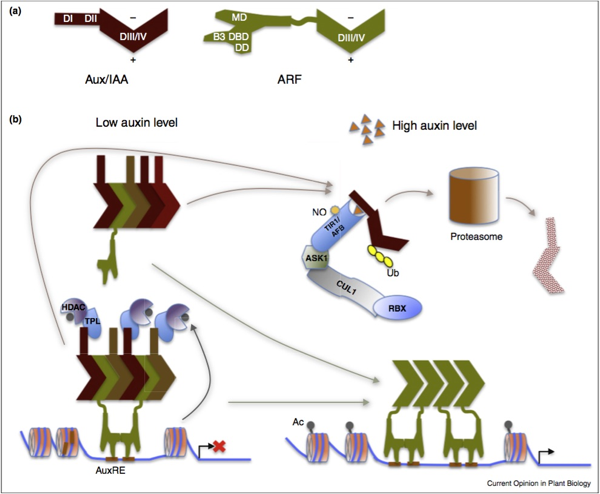Auxin Research
The plant hormone auxin has been implicated in virtually every stage of plant growth and development from embryogenesis to senescence. Our laboratory is using genetically tractable plants Arabidopsis thaliana (a flowering plant) and Physcomitrella patens (a moss) to identify and characterize auxin perception and response pathways. Our work has shown that auxin promotes the rapid degradation of a family of transcriptional repressors called the Aux/IAA proteins via the ubiquitin proteasome pathway. Auxin acts as a "molecular glue" between SCFTIR1/AFB E3 ubiquitin protein ligases and the Aux/IAA proteins which leads to the degradation of the latter. We are now studying the mechanism SCFTIR1/AFB action and the role of the complex in various aspects of plant growth. In addition, we are turning our attention to the complex transcriptional networks that mediate auxin growth responses. Our ultimate goal is to understand the systems that mediate auxin-dependent development at the level of the cell and organism.

A model for the TIR1/AFB-mediated auxin signaling pathway.
(A) DIII/IV regions of Aux/IAAs and ARFs are homologous and the DIII/IV of most Aux/IAAs and ARFs form a PB1 domain that comprises both an acidic (+) and a basic (−) face.
(B) When auxin level is low, Aux/IAA proteins and ARFs form multimers through directional interaction between the acidic and basic interfaces of their DIII/IV regions. Aux/IAAs in the multimers recruit co-repressor complexes, which consist of TPLs and HDACs and repress transcription of target promoter through removing acetyls (Ac) from local chromatin. In addition, Aux/IAAs in the multimers may block ARFs from efficient binding to AuxREs in their target promoters. When auxin level is high, auxin promotes ubiquitination and degradation of Aux/IAAs through a SCFTIR1/AFB-proteosome module, and the released ARFs form dimers and even higher-order complexes that activate expression of target genes.
From: Wang and Estelle. Current Opinion in Plant Biology 2014, 21:51-58.